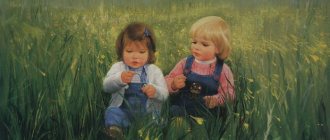Planning lessons on traffic rules in the middle group
Drawing up long-term plans is regularly carried out in preschool institutions. Teachers prepare notes for each event, approved by methodologists.
The daily routine in a preschool institution for children in the middle group should be designed in such a way that no more than 25 minutes are devoted to one lesson. The entire period of time is divided into four stages:
- Introductory is the beginning of a lesson that should attract the attention of the children and show the relevance of the topic. You can start the lesson by reading a short story, showing a picture, illustration, or the arrival of a fairy-tale hero.
- No more than 10 minutes are allocated for the central stage of the lesson. It includes a detailed examination of the topic, consolidation of existing knowledge. The main part may include physical education and gymnastics.
- 7 minutes are allocated in the third part of the lesson to consolidate the material received. Children must organize information. It is played out using various educational techniques.
- At the final stage, the teacher evaluates the activity.
Planning annual activities
In order to understand whether the lesson objectives have been achieved, a detailed analysis must be carried out. It is divided into two types:
- introspection;
- analysis of those present.
Diagnostics of the thinking of preschool children
The first type refers to the independent preparation of a report by the teacher. In the second case, a methodologist comes to the lesson and carries out an analysis based on the results.
If an open session was held, a group analysis may be given. Most often it consists of an oral discussion.
Examples of projects on traffic regulations for preschool educational institutions
Projects on the topic of traffic rules can be both creative, playful and educational. The teacher can combine them at his discretion.
Additional Information! One type of project could be conducting classes on the topic “Safe Street”. It is appropriate to hold a set of events in September, when children have returned from summer vacation. The goal of the project is to introduce and consolidate the child’s knowledge of road signs and the rules for using them.
For children of middle preschool age, it is recommended to conduct classes in a playful way with the involvement of fairy-tale characters. For example, a sparrow flies to class and tells how his friend’s ball jumped out onto the roadway where there is no pedestrian crossing or traffic light.
After watching the skit, you can conduct a drawing lesson or quiz. Then arrange an exhibition and presentation of the drawings. The project can be implemented jointly with parents. For example, hold a mock-up or crafts competition in advance, and after viewing the skit, hold a vote and determine the winners.
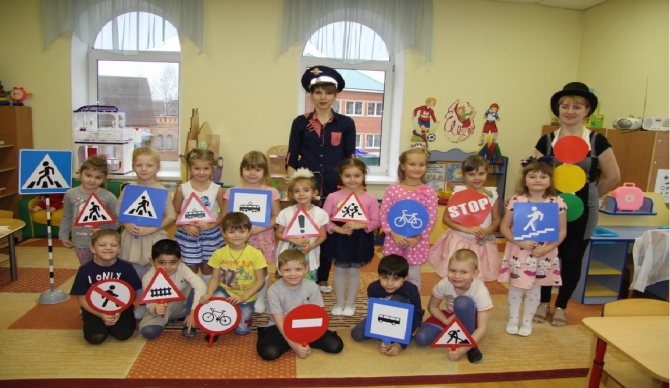
Theatrical scenes on the topic
GCD according to traffic rules for the middle group according to the Federal State Educational Standard
The program objectives of GCD on traffic rules in a preschool institution for middle-aged children are:
- consolidating children’s knowledge about road signs and traffic lights;
- systematization of available information;
- analysis of possible situations on the road;
- developing the ability to answer questions with complete answers;
- replenishment of vocabulary.
Preference is given to playful or theatrical forms. Children understand complex information more easily if it is presented visually. Therefore, a lesson on traffic rules must necessarily be associated with showing illustrations, road layouts, and crossings.
Additional Information! The lesson can be organized on the street, creating a traffic environment where children will be independent participants.
A lesson on traffic rules in the middle group is one of the main directions of the educational process in preschool educational institutions. The result - the safety of the child - will depend on how clearer, more varied and interesting the material is presented to children!
Types of activities
The process of developing knowledge about traffic rules in children in the middle group can be carried out through the use of various types of activities, didactic material, illustrations, fiction, and multimedia applications.
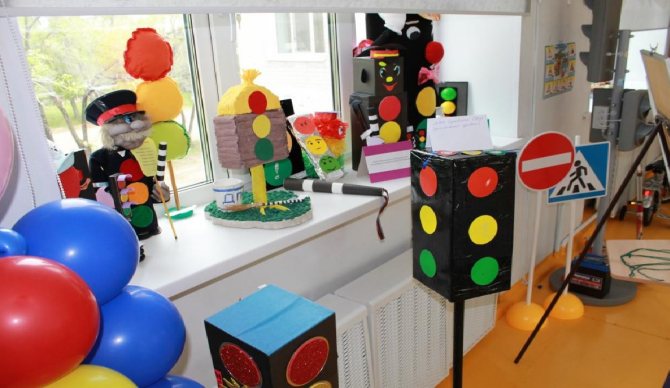
Introducing your child to road signs
The objectives of the classes, both in a long-term project and during a short-term period of familiarization with the topic, are:
- Introduce children to the meanings of traffic lights, expanding existing ideas.
- Introduction to modes of transport.
- Providing knowledge about the street, sidewalk, roadway.
- Familiarity with the basic rules of the road.
- Fostering a culture of behavior in transport and on the street.
Mastering the basics of safety is the daily work of both teachers and parents. To achieve the set goals, any available forms and methods of interaction can be used, both in the form of entertainment and educational activities.
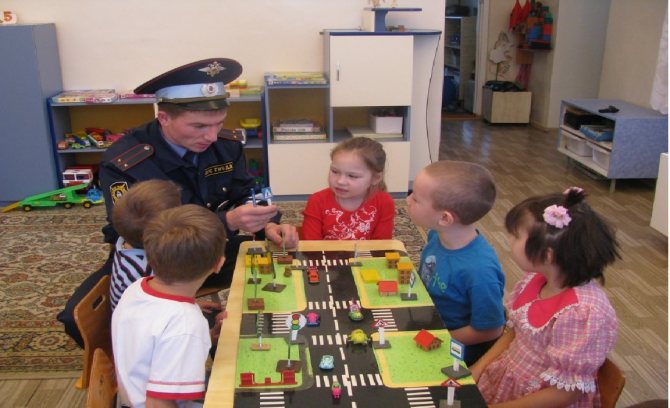
Conducting a conversation at a preschool educational institution
Short term projects
All classes conducted in preschool institutions comply with pre-drawn plans. Short-term projects are carried out as regular activities aimed at studying traffic rules. They may be dedicated to certain holidays. Most often, parents are involved in participation.
The projects involve holding exhibitions. For example, children, together with their parents, make models of roads, traffic lights, and pedestrian crossings at home. A city or regional work competition may be organized.
A short-term project can be a group activity in which children create a collage of appliques, drawings or crafts around a theme.
This method allows not only to consolidate the acquired knowledge about transport and road signs, but also to show creativity.
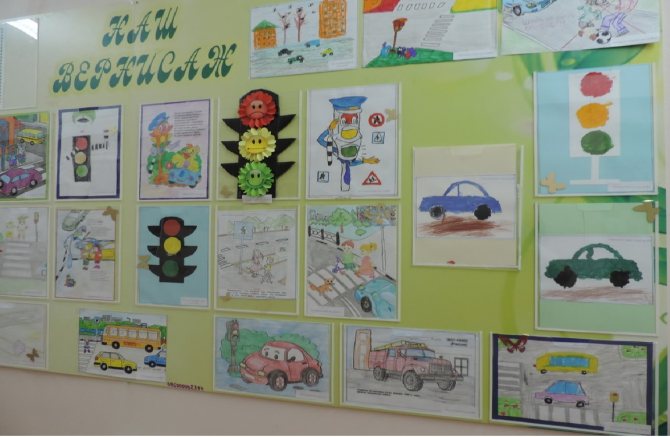
Organization of exhibitions on traffic rules
Conversations
Conversing with preschoolers in kindergartens is one of the most common forms of acquiring knowledge. It can be carried out both in the morning circle and in extracurricular activities, for example, on a walk. Any trip to the theater, museum or library can be compared to a conversation about traffic rules, when the teacher uses live examples to tell the child about behavior on the road.
Lessons on fairy tales in senior groups of preschool educational institutions according to the Federal State Educational Standard
Additional Information! This type of educational activity such as conversation should be carried out comprehensively. Parents play an important role in this situation. The task of educators is to explain to parents the meaning of their conversations with their children.
Open classes
Open classes can be held in various forms. These could be theatrical performances in which the children themselves take part, or inviting representatives of the traffic police to conduct a lesson.
The objectives of the classes are:
- expanding children's understanding of the street, sidewalk, roadway;
- familiarization with the concept of pedestrian crossings, traffic lights, rules of use.
During the classes, the children not only acquire new knowledge and consolidate existing knowledge, but also develop a desire to help others on the road.
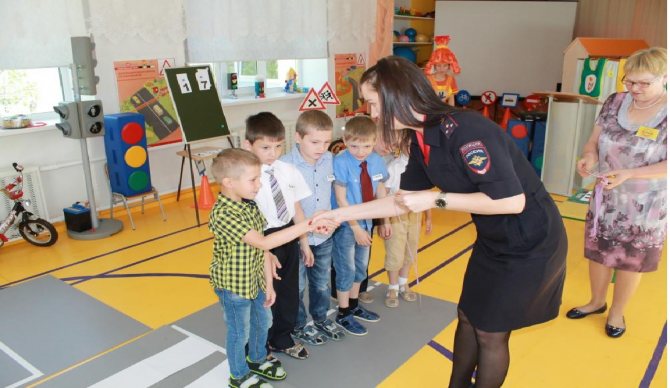
Form of open classes
Integrated classes
An integrated lesson means a combination of different types of activities in a certain period of time. For example, holding a quiz after watching a play or reading a story about traffic rules.
The lesson can be structured as follows. The fairy-tale hero Traffic Light will come to the children and tell him about his friend the dog, who ran across the road at the wrong red light. The traffic light will tell the kids that the car didn’t have time to stop and ran over the dog’s paw. He is now in the hospital. After this, you can conduct a drawing lesson, ask the children to draw drawings for the dog, which will reflect the rules on how to cross the roadway correctly.
Traffic rules week
According to the standards of the Federal State Educational Standard for preschool education, social and communicative development should be aimed at mastering the basic values and safety standards accepted in society. It is recommended to divide the educational process into thematic weeks.
A separate week should also be devoted to studying traffic rules, which includes complex activities. These could be combined open lessons, organizing meetings with traffic police officers, quizzes, and theatrical skits. In parallel, work should be carried out with parents.
Note! Classes can be conducted both collectively and individually. The variety of methods makes it possible for each child to find exactly what is more understandable to him. If a child does not like to draw, but listens to stories with great pleasure, he will better perceive information during conversations and reading fiction.
Carrying out activities on traffic rules in kindergarten
Thematic lessons dedicated to child safety should be conducted throughout the school year.
Additional Information! The short-term project on traffic rules in the middle group of kindergarten occupies one of the central places in the plan of activities.
A file of a long-term lesson plan for the year may look like this:
| Execution period | Event |
| September | Conducting consultations with parents |
| Design of traffic rules corners in groups | |
| Carrying out a game according to the rules of the road | |
| Reading works on this topic | |
| October | Conducting an open lesson with the invitation of a traffic police officer. Creating a conversation on the topic “City Streets” |
| Organization of creative activities on the topic. | |
| December | Competition among groups for the best road layout |
| January | Theatrical performance on the theme “Road Signs” |
| February | Conducting a parent meeting “Children’s safety on city streets” |
| March | Organization of traffic rules week |
Outline of a lesson on life safety (middle group) on the topic
- Summary of GCD on safety “Caution, winter road”
- Goal: instilling skills for safe behavior on the road in winter.
- Tasks:
- Educational: introduce the rules of safe behavior on the road in the winter season, the new concept of “pavement”, teach children to act on a signal and in accordance with the rules in the game.
- Developmental: develop attention, improve coordination of movements, develop speech and activate children's vocabulary.
- Educational: to cultivate a conscious attitude towards the norms and rules on the road in winter, the ability to apply road safety rules, and to instill in children a culture of behavior on the street.
- Progress of the lesson:
- Organizing time.
- Greetings:
- Let's stand side by side in a circle
- Let's say "Hello!" each other
- We are not too lazy to say hello
- “Hello” and “Good afternoon” to everyone
- If everyone smiles
- Good morning will begin.
Educator: Guys, guests came to us today.
Let us smile at our guests and say “Good afternoon.”
Educator: While you were sleeping, they brought this unusual box to our group. What do you think is inside?
- Now I’ll tell you a riddle, and can you guess what’s inside?
- "On the paths, along the paths
- Who walks on snowy feet?
- Who is capable of tricks
- Does his nose look like a carrot?”
- Children: snowman
Educator: What an unusual snowman. What do you think we will talk about now? What time of year is it now? When are you and I making a snowman?
Children: in winter
Educator: But our snowman is not simple. Look what's on it?
Children: traffic lights, road signs, policeman, etc. (look at a snowman)
Educator: That's right, today we will talk about the peculiarities of the rules of conduct on the road in winter.
Educator: So, it’s winter outside, the roads are covered with an ice crust, and if it snows, then there’s also snow, under which the ice is hidden. This phenomenon is called ice.
Winter is a dangerous period for drivers and pedestrians. Many accidents on the roads occur in winter and pedestrians also need to be careful not to fall.
Tell me guys, how do drivers prepare their cars for winter? (children's answers).
Are people and pedestrians preparing for winter? (children's answers)
Yes, people wear warm clothes, and even better, wear shoes with non-slip soles. And having slipped and fallen on the street, a person hurries to get up, but there is no need to rush, first you need to examine yourself: move your arms and legs. If there is no pain, you can get up.
- Educator: Remember the rules: do not push, do not run, do not play on a slippery road, and if someone falls, help them up, call an adult for help.
- Children sit on chairs.
- Educator: Guys, how many of you know what “Pavement” is?
- I suggest watching the presentation and learning a little about paving.
Slide 1. A long time ago, when there were no cars, people rode horses.
Slide 2. To prevent carts from getting stuck in the mud, logs were laid on the road or lined with stones. It was called "pave."
Slide 3. At first they said “bridge road” with respect. Over time, they began to simply say “pavement.”
Slide 4. Now the roads are being asphalted, but the word, as a definition of the roadway, remains.
- Listen guys to the poem “Ice”
- February was warm like April
- Suddenly it froze
- And then there’s the snowstorm
- She threw it on the sidewalk.
- The blue bus is sliding.
- No wonder the driver is worried -
- Schoolchildren in a crowd
- They cross the street.
- One fell, another fell,
- Haste is no help:
- One rubs the back of his head with his hand,
- The other winces in pain.
- The driver took the trouble away from them
(This doesn’t always happen)…
- Playing pranks on the ice on the pavement,
- Of course it is prohibited.
- (I. Leshkevich)
- Looking at picture 1
Indeed, on the road in winter, especially in icy conditions, both pedestrians and drivers need to be careful. The roads are slippery and it is difficult for the driver to stop the car. You cannot run across in front of nearby vehicles, because
Even if the driver brakes, the car will continue to move on the slippery road for some time.
Therefore, you need to wait for the cars to pass, and if there is a traffic light at the crossing, then you need to wait for the green light and only then cross the road.


